Losses, negative biological performances, a significant change in the species mix from trout to salmon, mergers and acquisitions have been among the most frequent concerns in the Chilean salmon industry over the past months.
By Christian Perez Mallea

In recent months, the acquisition of Cultivos Marinos Chiloé for US$ 110 million by the Norwegian company Cermaq ASA, probably transpired as the main corporate consolidation within the national salmon industry.
As reported by Cermaq, with this transaction which materialized in October 2012, the company increased its staff by 1,500, while its Chilean production capacity grew by about 50 percent.
Similarly, Salmones Pacific Star completed the purchase of its competitor company, Trusal, by the middle of this year for US$ 60-80 million leaving Trusal in control of one third of the new joint venture.
While Trusal exported about 17,700 tonnes of salmonids last year, Pacific Star totaled around 12,100 tonnes. The combined capacity would mean that the new firm is the fifth largest salmon and trout exporter in Chile, surpassed only by AquaChile, Mainstream Chile, Acuinova and Los Fiordos.
Finally, in recent months another notable acquisition was that of the Pacific Seafood assets by Salmones Friosur, a company that just a few months before had bought the aquaculture division of Pesquera Landes (now Salmon Frioaysén). Both operations represent a total of 27 new aquaculture licenses and the possibility of expanding its production plan from 11,000 tonnes exported in 2012 to a potential of close to 100,000 tonnes per year.
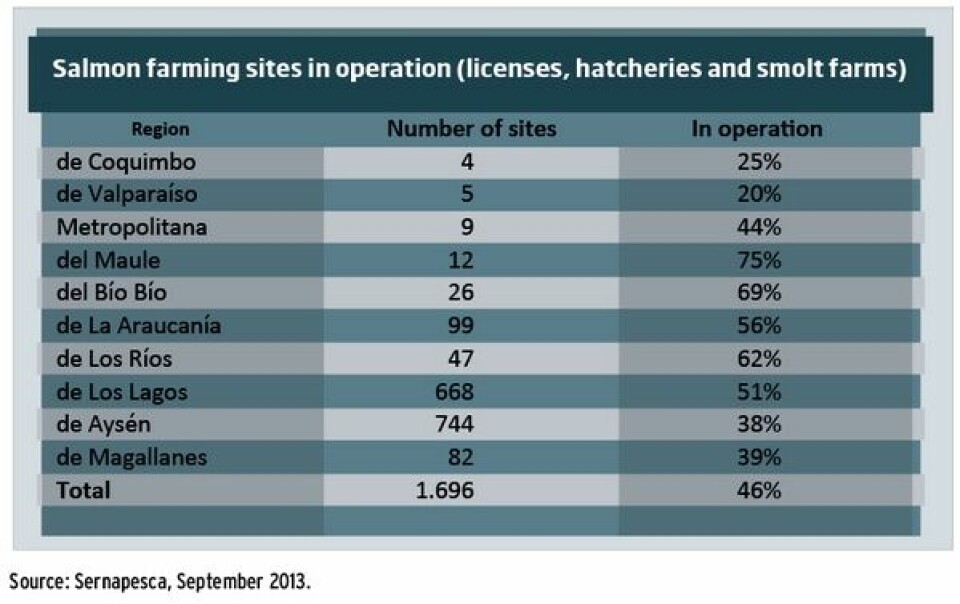
Figures for 2012 According to preliminary data of the National Service of Fisheries and Aquaculture, Sernapesca, over 820 000 tonnes of salmonids were harvested in Chile in 2012. In order to farm these fish, the salmon producing companies held 591 licenses at sea (see Table 2), representing an increase of 18.67 percent compared to the 2011 data.
The largest increase was seen in the region of Aysén, where 55 more licenses were granted in 2012, compared to the previous year.
The salmon producing companies reporting to the Chilean Securities and Insurance Supervisor (AquaChile, Australis Seafoods, Blumar, Camanchaca, Invermar, Los Fiordos and Multiexport Foods) as well as Norwegian companies with salmon farms in the country but listed on the Oslo Stock Exchange (Mainstream Chile and Marine Harvest Chile), reported a total of 789 aquaculture licenses. However, on average, only about one third of those permits were used last year.
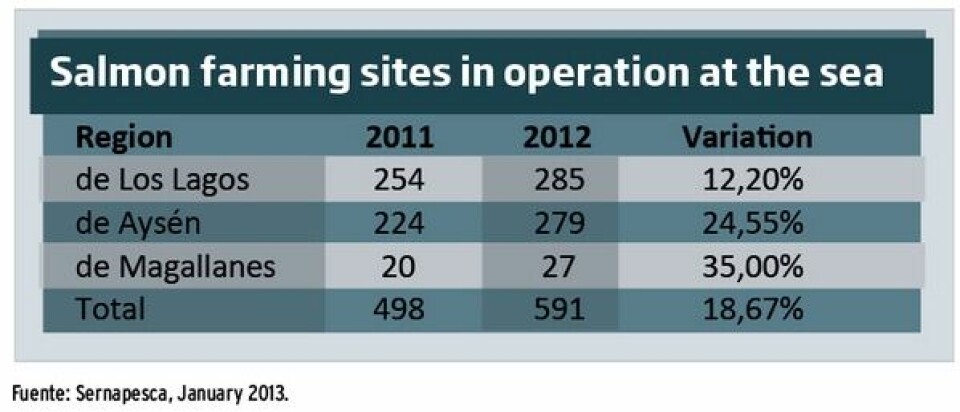
Empresas AquaChile AquaChile is the largest salmon producing company in Chile in terms of both volume and returns. AquaChile owns 163 aquaculture licenses (151 at sea and 12 in lakes), of which the company operated just 54 in rivers and at sea, as well as 5 in lakes last year. These were mainly located in the regions of Los Lagos and Aysén.
In addition, it has five processing plants located in the area of Puerto Montt, Calbuco and the island of Chiloé. In this regard, it should be mentioned that in 2012 the company reopened its Puerto Montt plant which had been closed for three years.
The company expected to harvest about 22,100 tonnes in Q3, 2013, according to the company’s Q2 statement. If so, the company would have harvested nearly 73,000 tonnes in the first nine months of this year. This figure is higher than the total harvest of AquaChile throughout 2011 and only 14 percent below those recorded in 2012 (84,810 tonnes, see Table 3).
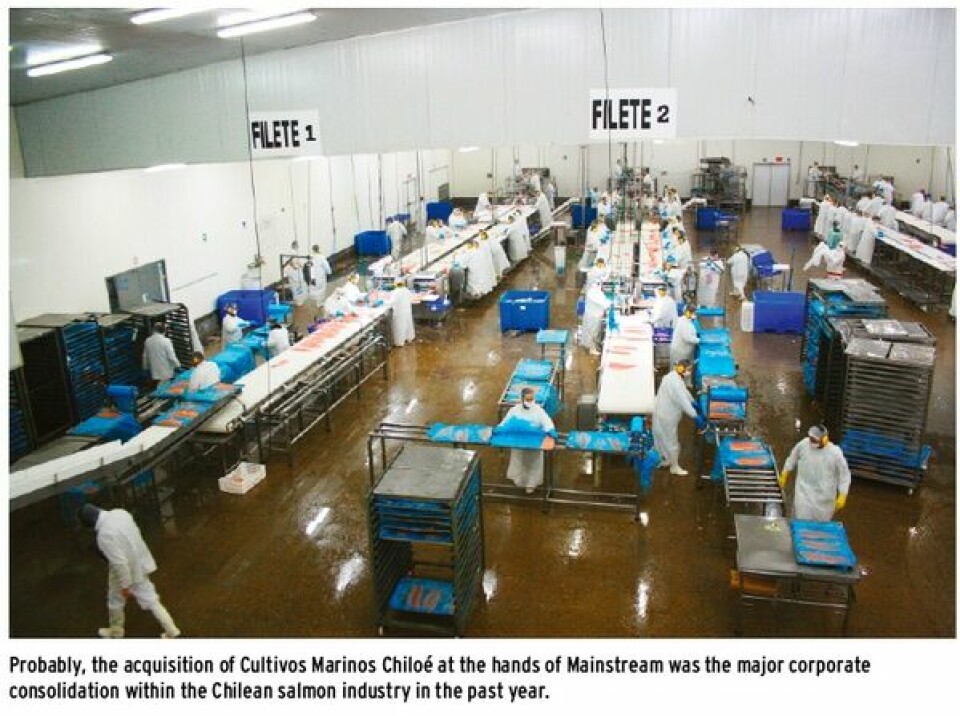
AquaChile also reported that the company: - was continuing with its plan to recover productivity levels with increases in harvest volumes; - reached higher sales volumes in all farmed species compared to Q2, 2012; - foresaw a favourable price scenario, reporting faster than expected growth in the first six months, especially for Atlantic salmon; - registered lower results (income?)mainly due to the decline in the sales margins for Atlantic salmon and trout; - as a result of part of the biomass of Atlantic salmon and trout having been affected by a greater abundance of sea lice, was faced with higher treatment costs, a higher fish feed conversion rate and a slower growth rate, resulting in lower harvest weights, a lower dilution of fixed costs and limits to the commercial optimization of the productive mix; - expected a recovery in harvest weight and quality in the second half of the year since an important part of the biomass which is in the zones worst affected by sea lice has already been harvested.
Finally, the company launched its Chaicas RAS freshwater site in 2012. This project required an investment of around US$ 25 million and will have an annual production of 120 million disease-free eggs and 4 million Atlantic salmon smolts. In addition, this facility will contain the company’s genetic programme based on 120 families of Atlantic salmon .
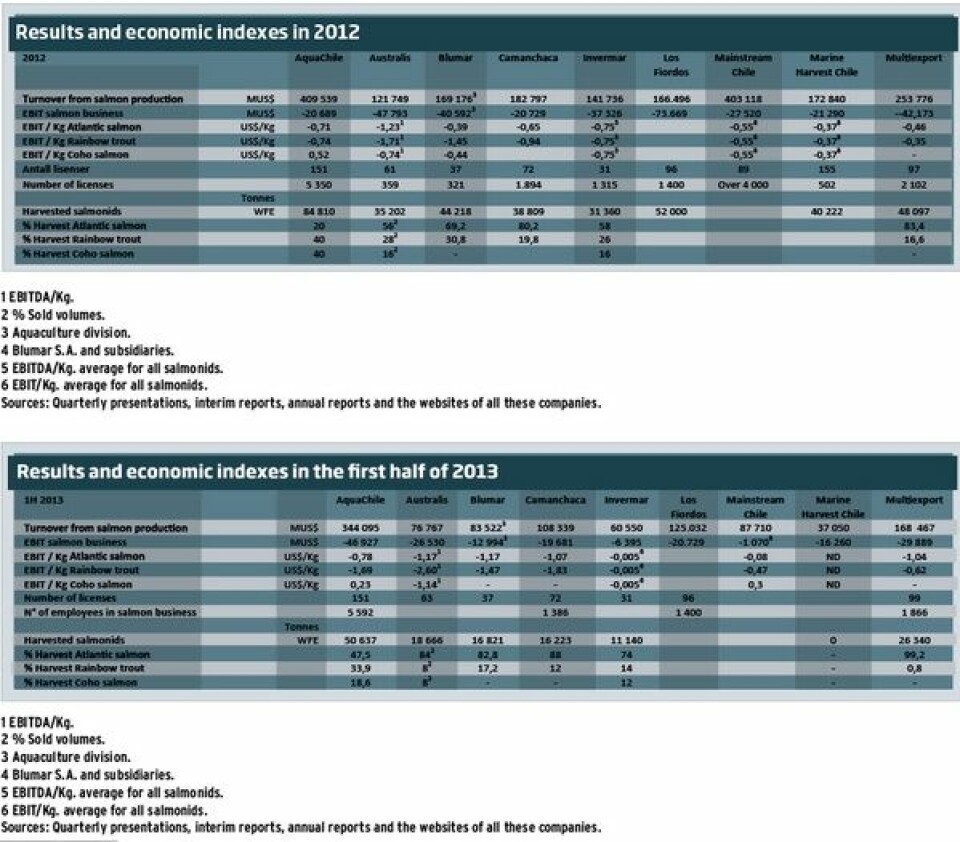
Mainstream Chile Just like AquaChile, Invermar, Los Fiordos and Marine Harvest Chile, Mainstream Chile is also headquartered in the city of Puerto Montt and farms three species of salmonids in our country: Atlantic salmon, Coho salmon and Rainbow trout. In addition it also covers the value chain from brood fish to value added processing.
This company runs 12 land freshwater sites and is present in 3 lakes dedicated to smolt production (coho and trout). In contrast, all Atlantic salmon smolt stocked was produced in land based facilities. Mainstream Chile has 89 aquaculture licenses for on-growing and four processing plants.
Most of the company’s sea sites for coho and trout are located around Chiloé Island, while almost half of its Atlantic salmon is produced in the regions of Aysén and Magallanes.
Globally, Mainstream is expecting to sell 150 000 tonnes of salmon in 2013, compared with 120 000 tonnes in 2012. This is an increase of 25 percent. Mainstream Chile is the driver behind this growth, with a planned sales increase of 31 000 tonnes. The acquisition of Cultivos Marinos Chiloé, which was consolidated in Q4 2012, accounts for 11 000 tonnes of that increase.

Salmones Multiexport Multiexport has 97 aquaculture licenses in Chile and has been operating 39 of them over the past year (8 in the region of Los Lagos and 31 in the region of Aysén). The company also has two processing plants, one for the production of fresh and frozen fish, and another for smoked products. Together, they have a processing capacity of close to 75,000 tonnes of raw material per year. In 2012, the total production was 72,120 tonnes.
As reported by the company in its Q2 2013 presentation, Multiexport will reduce its harvests between 3 and 13 percent this year, depending on the convenience of either early or late harvests, considering market demand and sanitary status. Thus, Multiexport should harvest between 42,000 and 46,500 tonnes of salmon and trout in 2013, compared with 48,100 tonnes last year.
Regarding prices, the company expects a balanced market for Atlantic salmon, priced in the medium-high range with significant increases in the price of both Coho salmon and trout as a result of adjustments in the production and supply, mainly from Chile.
Among other noteworthy events for the company during 2013, Multiexport signed a joint venture with the Japanese company Mitsui & Co. Ltd on January 11th, aimed at producing and marketing trout and Coho salmon in Asia, with special emphasis on Japan and China. Mitsui acquired a 30 percent stake in the joint venture worth US$ 36 million and have the option to purchase an additional 10 percent at the same price. This option runs out in March 2014. Multiexport is the controlling shareholder of the joint venture and manages the operation of the new company.
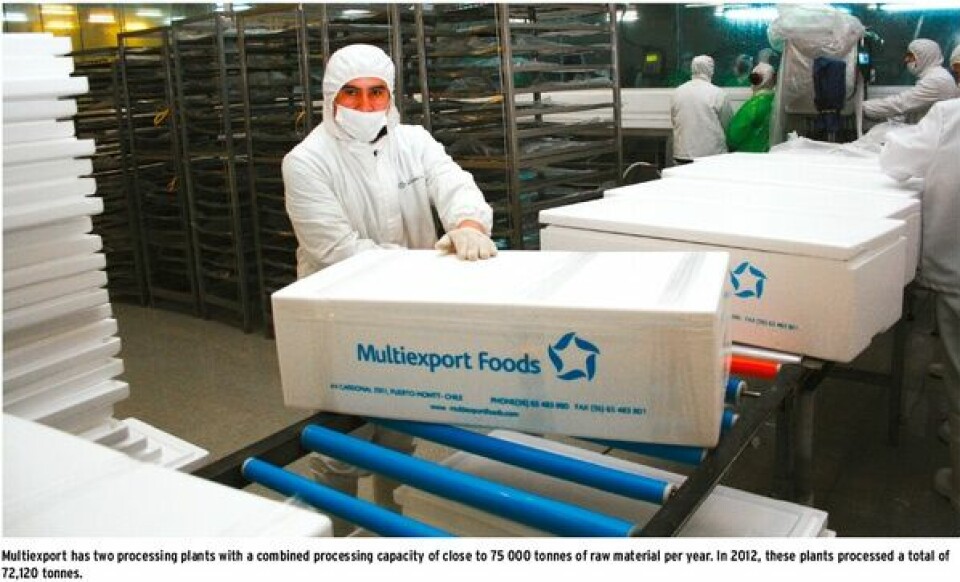
Marine Harvest Chile Marine Harvest Chile was running 10 marine sites in the region of Los Lagos by October this year, as well as 9 freshwater sites in the regions of La Araucanía and Los Lagos.
Until 2007 and before the first outbreak of the ISA virus in Chile, Marine Harvest operated up to five plants for primary, secondary and VAP processing in the country. Currently, and after the closure of the smoking plant Delifish last September, the company runs only one processing plant in Caicaén near Calbuco. Besides this, the company also employs contract services for the processing of fish produced at its farms.
This situation is probably in response to the cautious approach that Marine Harvest maintains in Chile. According to the company, the biological cost of Chilean salmon increased in 2012 and the number of delousing treatments escalated. The survival of the fish remains good, but is, as expected, moving towards a slightly lower survival rate. The new regulations are good news. The company believes thatIf these are implemented and enforced it will secure the future for Chilean salmon farming considerably..
Regarding biological performance, the growth rate for fish at sea declined during the year and the current generations are growing significantly slower than previous ones, which has contributed to increased costs per kilogram. “Compared to 2011, the biological cost for our Chilean salmon increased by 12 percent (...) and is now higher than for salmon of Norwegian origin. Among other challenges, the company mentioned that Chile was the only region where they recorded a higher lice count at year end 2012 compared to year end 2011.
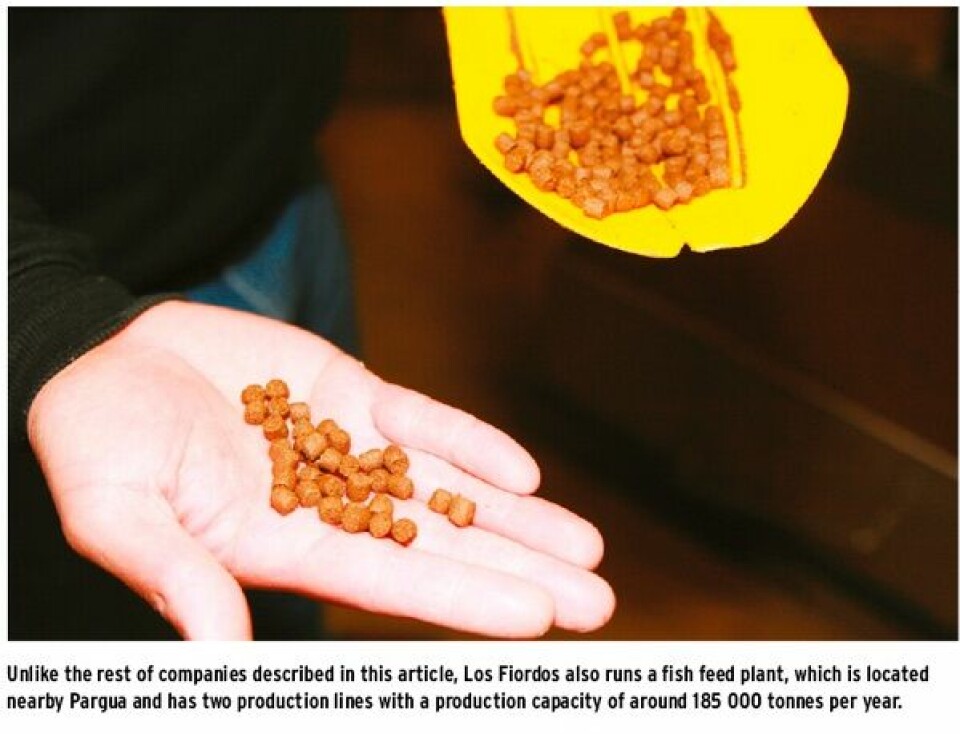
Los Fiordos Los Fiordos has two land freshwater facilities for the production of Atlantic salmon smolts and another one for breeders of the same species in the region of La Araucanía, with a combined capacity of 24 million smolts and 80 million eyed eggs. In addition, it has another two land freshwater sites for smolts and breeders, of both Coho salmon and Rainbow trout. Together, these sites have a combined capacity of close to 14 million eyed eggs and 12.45 million smolts.
Furthermore, Los Fiordos is active in two major on-growing areas located near Melinka and Puerto Cisnes, with 14 and 8 operating sites in each area, respectively. The company also owns the largest processing plant for salmonids in Chile, located in Quellón in the south of Chiloé Island and with a production capacity of close to 130 000 tonnes per year.
Unlike the other companies described in this article, Los Fiordos also runs a fish feed plant, located near Pargua, operating two production lines with a combined capacity of around 185 000 tonnes per year.
The company reported a significant increase in Atlantic salmon prices in the first half of 2013, which offset increased costs in the same period. This increase was caused mainly by sanitary problems and a significant increase in the price of fish feed raw materials and inputs. However, the sanitary status was normalized by the second quarter while the prices for major feed inputs have been decreasing (fish meal has declined 25 percent compared to its peak price this year).
“We expect improved production results in the second half of the year, which would mean higher yields and fish sizes as well as improved margins and reduced losses in this business segment”, a company spokesman states.
Sady Delgado, general manager of Los Fiordos, commented that the company expects to harvest around 67 000 tonnes of salmonids this year, itemized in about 56 000 tonnes of Atlantic salmon and 11 000 tonnes of Coho salmon. This result would represent an increase of almost 30 percent compared to the results obtained by the company in 2012.
Salmones Camanchaca Salmones Camanchaca owns five land freshwater sites and currently operates four of them (Polcura, Río del Este, Río de la Plata and Río Petrohué). Petrohué, which was launched in 2000, still transpires as the largest RAS facility in the world with a production capacity of around 15 million smolts per year. Meanwhile, the company maintained 25 farming sites in operation last year.
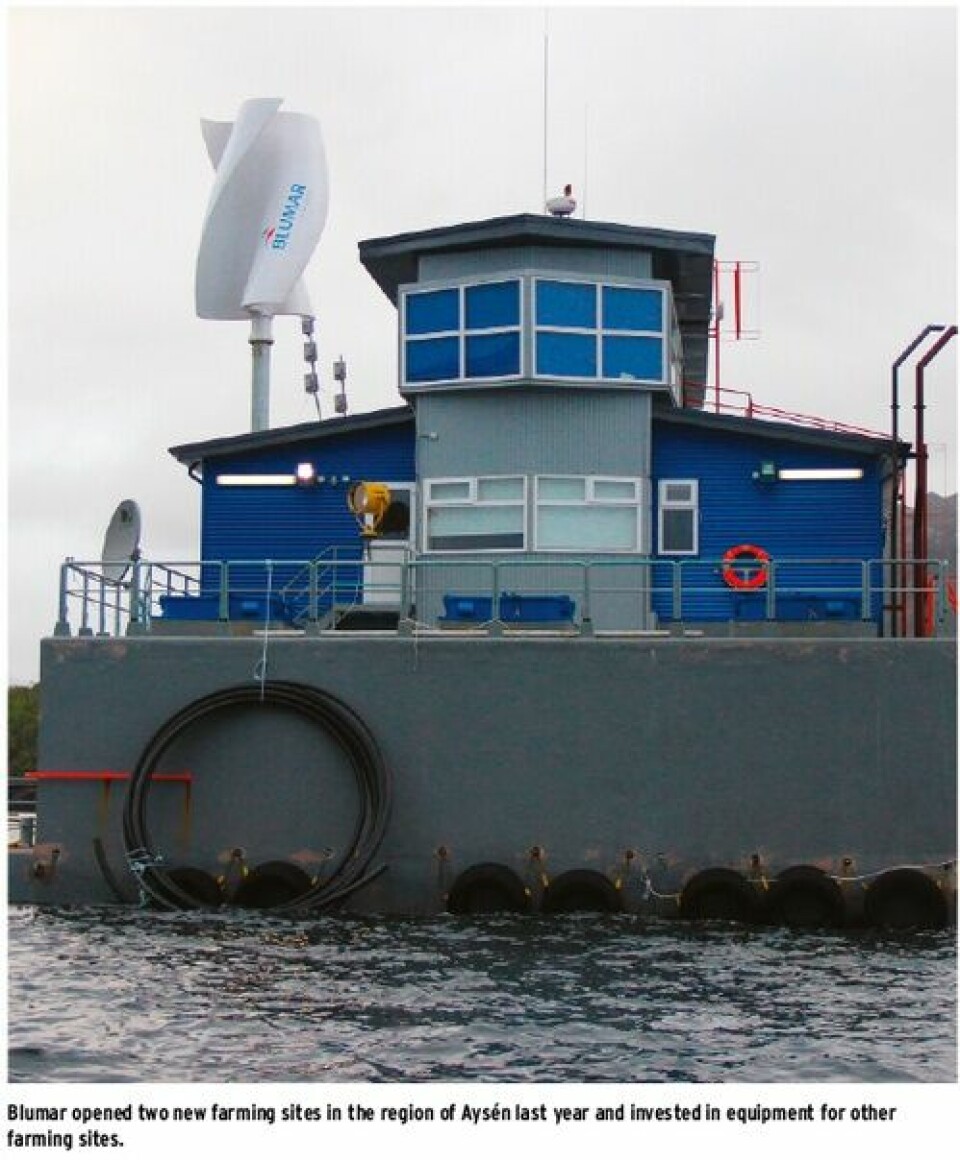
In late 2008, due to the effects of the crisis triggered by the ISA virus in Chile, Camanchaca decided to stop farming Atlantic salmon in the sea until the sanitary conditions hadimproved. New regulations and production practices, together with the development of new vaccines, explains why the company started stocking Atlantic salmon in September 2010. Camanchaca resumed its former production levels by 2012 when it produced close to 40 000 tonnes WFE, which is the production goal established by the company after the crisis.
Regarding the decreased biological performance of fish last year, Salmones Camanchaca considers that the average figures do not reflect the significant differences between farming sites. The company explains that the large biomass of Atlantic salmon in Macrozone 6 (near Melinka where 3 ISA outbreaks were reported this year) generated a sharp increase in the abundance of sea lice, increasing the costs for delousing treatment, reducing FCR’s and causing immunosuppression in fish, which exposed them to other diseases. Furthermore, SRS generated higher than expected mortality rates in trout and forced the company to harvest smaller fish, resulting in higher costs in Q2 2013.
Camanchaca harvested all its fish in the region of Aysén in July this year, in accordance to its 2013 plan, leaving only fish sites located in the region of Los Lagos for the rest of the year. These sites have had very positive sanitary and cost conditions up to September this year.
Blumar This company does not have its own hatcheries or smolt farms. Instead, Blumar has a share in the Chilebreed consortium, which was created along with Acuinova two years ago, with the aim of producing salmon eggs. Blumar also has an option to buy one of the freshwater sites that it is currently using. This facility has an annual production capacity of 7 000 Atlantic salmon smolts.
Today, the company has 37 licenses,36 of which are located in the region of Aysén and one in the region of Los Lagos. Twenty of them are operational and used for Atlantic salmon and trout on-growing. In addition, Blumar runs a processing plant located in Talcahuano with a production capacity close to 25 000 tonnes per year.
The company invested US$ 18 million in its aquaculture division last year with the intention of expanding the capacity of its salmon processing plant. Furthermore, they opened two new farming sites in the region of Aysén and invested in equipment for other farming sites.
In the company’s Q2 statement, Blumar shows a slight improvement in the salmon production costs, reflected in better FCR’s despite higher mortality rates in this quarter. The company experienced massive mortalities at two farming sites last March due to low oxygenation caused by algae blooms.
In commercial terms, the company said that rising market prices continued during the quarter only counterbalanced by seasonal adjustments in the price of Atlantic salmon.
Australis Seafoods Australis freshwater activities are conducted in the facilities of its subsidiary company Landcatch Chile, located in the Metropolitan, Bío Bío, La Araucanía, Los Ríos and Los Lagos regions. In addition, the Australis Seafoods group (ASF) had 60 marine licenses up to December last year, located in 2 areas of the Los Lagos and 13 in the Aysén region.
Also until last year, ASF had contracted services for holding pens, slaughtering and processing in third-party plants located on Chiloé Island and in Puerto Montt. However, in addition, the company acquired the Fitz Roy processing plant, which had previously belonged to Mainstream Chile. This facility will initially process up to 40 000 tonnes per year.,During its first quarter in operation, it has already reduced ASF processing costs by US$ 0.12/kg WFE compared to the previous quarter. The company expects to improve our operation and achieve savings of close to US$ 0.20/kg WFE.
Likewise, ASF agrees with the analysis made by other producing companies about the local industry: implementing the new regulatory framework and controlling the sanitary status are key elements.(for what?) In this regard, it stressed that the two main diseases affecting biomass at sea (Caligus and SRS) are still affecting the fish survival rates. “Some ASF farming sites have been more affected by increased sea lice and SRS than the industry average, which has resulted in higher mortality rates, more frequent delousing treatments and deteriorated FCRs, which together have lead to lower growth rates and higher costs,” the company explained. Besides, ASF has taken some joint measures with other industry players through coordinated sea lice treatments over large geographical areas, drug rotation, whole tarpaulin bath treatments and a coordinated reduction of farming densities .
Invermar Invermar has four freshwater sites located in the regions of La Araucanía and Los Lagos, as well as two lake sites on Chiloe Island. The company also has 31 licenses for on-growing sites in the regions of Los Lagos and Aysén, 10 of which had been in use until last year.
31,361 tonnes of raw material passed through its processing plant in 2012, an all-time high for Invermar, a figure confirming that the maximum production capacity of this facility is close to 40 000 tonnes per year..
The company reduced its production level in the first six months of this year. Invermar harvested 11,140 tonnes WFE of salmonids in the first six months of the year compared with 14,580 tonnes in the same period of 2012, representing a 23.6 percent decrease. This situation is mainly due to the company’s decision to eliminate the Coho salmon and trout species from its production mix, in order to focus on a strategy based on high-value added products (portions) of Atlantic salmon.
Among other noteworthy events for the company this year, Salmones Cupquelán, Chilean subsidiary of Cooke Aquaculture, offered US$ 20 million for 54.07 percent of the total shares in Invermar last April. Four months of negotiations failed to result in an agreement. According to some leaked reports, among other issues, two of the twelve creditors banks would not have signed the document authorizing the operation because they were not willing to forgive one third of the liabilities involved.




















































